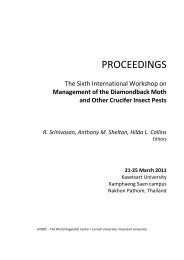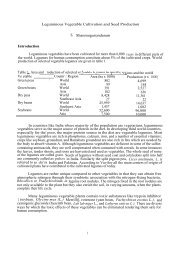Potato Virus Y on Pepper
Potato Virus Y on Pepper
Potato Virus Y on Pepper
- No tags were found...
Create successful ePaper yourself
Turn your PDF publications into a flip-book with our unique Google optimized e-Paper software.
<strong>Pepper</strong> Diseases<br />
<str<strong>on</strong>g>Potato</str<strong>on</strong>g> <str<strong>on</strong>g>Virus</str<strong>on</strong>g> Y<br />
Aphid-Transmitted Potyvirus<br />
Found worldwide<br />
Symptoms<br />
Plants can be infected at any growth stage by virustransmitting<br />
aphids.<br />
Symptoms of potato virus Y (PVY) include plant<br />
stunting, systemic vein-clearing, leaf mosaic or mottling,<br />
and dark green vein-banding of the leaves. Necrosis in<br />
the veins and petioles often develops. This may be<br />
followed by stem necrosis and defoliati<strong>on</strong>, death of the<br />
top bud and plant death.<br />
Affected fruit may be smaller, deformed, and with a<br />
mosaic pattern.<br />
PVY symptoms may be masked by symptoms of<br />
other viruses.<br />
World Vegetable Center<br />
C<strong>on</strong>diti<strong>on</strong>s for Disease Development<br />
Many species of aphid, including the green peach<br />
aphid, Myzus persicae, transmit the virus at different<br />
degrees of efficiency. The different aphid species can<br />
acquire the virus by feeding <strong>on</strong> an infected plant for<br />
less than a minute and can transmit it as quickly also.<br />
The aphids will retain the virus for periods of 1 day or<br />
l<strong>on</strong>ger if the aphids do not feed after acquiring the virus.<br />
PVY infecti<strong>on</strong> in tomato and tobacco is an important<br />
source of the virus for pepper. Weeds may also act as<br />
a reservoir for the virus in tropical regi<strong>on</strong>s.<br />
How to Identify <str<strong>on</strong>g>Potato</str<strong>on</strong>g> <str<strong>on</strong>g>Virus</str<strong>on</strong>g> Y<br />
Mosaic and dark green vein banding are the most<br />
typical symptoms<br />
Leaves crinkle and plants become stunted<br />
Written by Ray Cerkauskas, Visiting Scientist from Agriculture and Agri-Food Canada. Edited by Tom Kalb. Photos by Lowell L. Black.<br />
Published by AVRDC – The World Vegetable Center; P.O. Box 42, Shanhua; Taiwan 741; ROC<br />
tel: (886-6) 583-7801; fax: (886-6) 583-0009; email: avrdcbox@avrdc.org; www: www.avrdc.org
C<strong>on</strong>trol<br />
Resistant varieties are available. Check with your<br />
extensi<strong>on</strong> agent for resistant cultivars that are available<br />
in your regi<strong>on</strong>.<br />
Use of insecticides during the growing seas<strong>on</strong> is<br />
ineffective; however, c<strong>on</strong>trol of aphids early in the seas<strong>on</strong><br />
prior to seeding or planting the field, to reduce initial<br />
infecti<strong>on</strong> and spread, may be useful. Spray weeds<br />
bordering the field with an aphicide prior to seeding or<br />
planting the field. This will prevent the aphids from moving<br />
to other plants and infecting them when subsequent<br />
weed c<strong>on</strong>trol is started. Destroy all annual weeds in<br />
the field, including those in ditches, hedge or fencerows,<br />
and other locati<strong>on</strong>s.<br />
Use a 32-mesh or finer mesh netting to exclude<br />
aphids from transplants before they are set into the<br />
field. Avoid planting peppers close to established<br />
tomato, tobacco, and pepper fields since these fields<br />
may harbor aphids. Plant earlier to avoid high aphid<br />
populati<strong>on</strong>s that occur later in the seas<strong>on</strong>.<br />
Other c<strong>on</strong>trol measures include scouting fields for<br />
the first occurrence of virus disease. Where feasible,<br />
infected plants should be pulled up and destroyed, but<br />
<strong>on</strong>ly after spraying them thoroughly with an insecticide<br />
to kill any insects they may be harboring.<br />
Reflective mulches may be used to repel aphids,<br />
thereby reducing the rate of spread of aphid-borne<br />
viruses. Aphid populati<strong>on</strong>s should be m<strong>on</strong>itored early<br />
in the seas<strong>on</strong> and mineral oil or other insecticide<br />
treatments applied when needed. The mineral oil sprays<br />
will reduce the frequency of transmissi<strong>on</strong> of the virus<br />
by the vector and thereby delay development of the<br />
disease in the pepper crop.<br />
For more informati<strong>on</strong> <strong>on</strong> the producti<strong>on</strong> of<br />
pepper and other vegetables, go to<br />
.<br />
AVRDC Publicati<strong>on</strong> 04-587<br />
2004
















